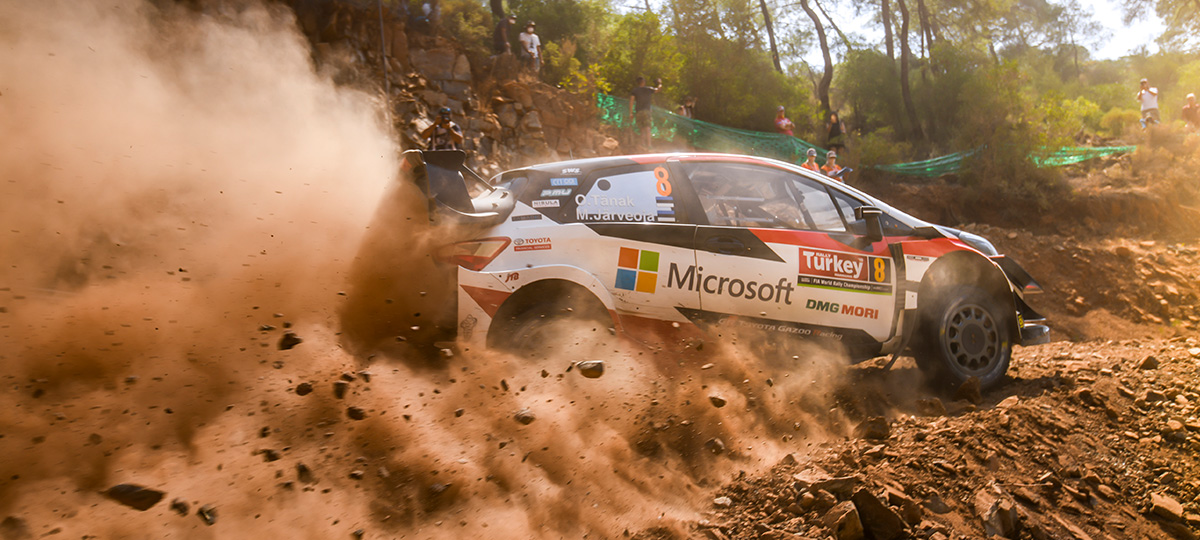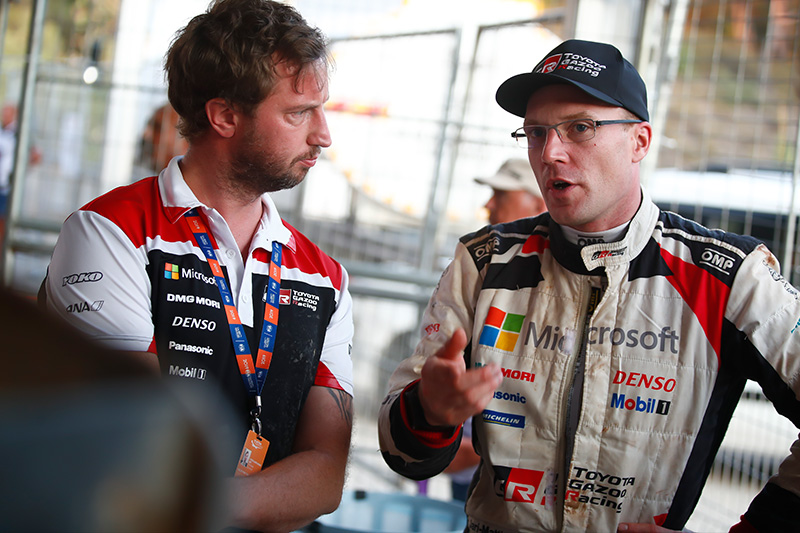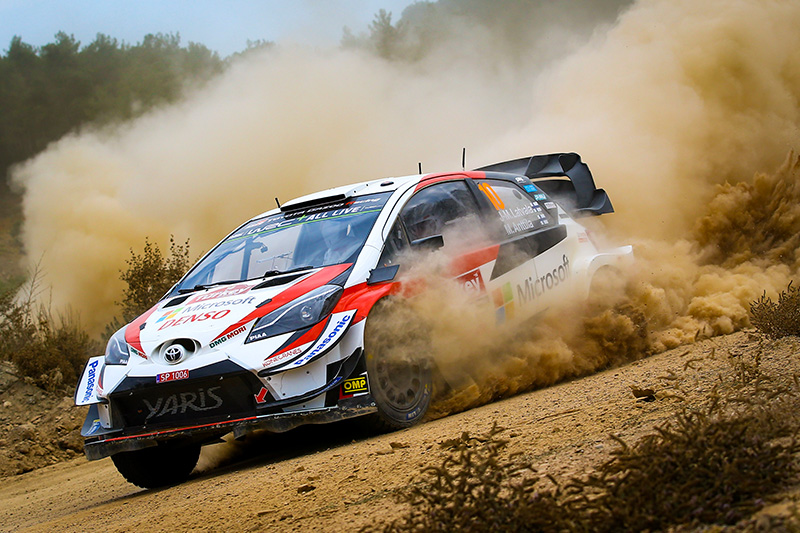2019 Rd.11 RALLY TURKEY
WRC 2019 ROUND 11 RALLY TURKEY

SUMMARY REPORT
The need for further performance and reliability improvements is made painfully clear
The smooth, high-speed gravel surfaces of Rally Finland, the tarmac surfaces of Rallye Deutschland, and the rough gravel surfaces of Rally Turkey—last season, Ott Tänak won all three rallies in the Yaris WRC, even though they differ greatly in type. In Turkey last year, Jari-Matti Latvala came second, so giving the TOYOTA GAZOO Racing World Rally Team its best result of the season with a one-two finish. However, the Yaris WRC was no match for its rivals in terms of pure speed. Tänak only managed to secure victory by driving cleverly—by ensuring the car would not break or puncture over the rough road surfaces. The team therefore recognized it had to improve the Yaris WRC’s performance significantly in Turkey, and embarked on a long-term process of development in the run up to this year’s edition.

The roads at last year’s Rally Turkey were perhaps the poorest of all of the season’s 13 events, and the team opted to firm up the Yaris WRC’s suspension settings to prevent the car’s front and rear ends and bottom from hitting the road due to vertical movement. However, hardening the suspension invariably leads to a loss of traction; the team identified this lack of traction as one of the reasons the Yaris WRC was not fast enough at last year’s Rally Turkey and therefore worked hard to improve its suspension. The team also endeavored to lighten the weight and improve the overall performance of the MacPherson struts, including the dampers.

The team was able to confirm performance improvements in its development tests. But tests are just tests. The team therefore entered a fourth Yaris WRC in Round 8, Rally Italia Sardegna, and put development driver Juho Hänninen at the wheel. By testing the new suspension in an actual rally on Sardegna’s gravel roads, the team was able to verify its performance and durability.

The suspension’s performance when firmed up had now been significantly improved. The team next carried out pre-event tests on gravel roads in Greece with the aim of optimizing these settings for Turkey’s roads. The Acropolis Rally of Greece used to be a WRC event, and was regarded as having some of the roughest roads of any rally. The team therefore considered it would be the ideal testing location for the new suspension settings. TOYOTA GAZOO Racing World Rally Team therefore entered the week of the rally having prepared thoroughly.

In the end, however, Jari-Matti Latvala’s sixth position turned out to be the team’s best result of the rally. Kris Meeke finished in seventh overall, with Tänak down in 16th. While this might seem like a painful defeat, there were three basic reasons for the poor results: punctures, mechanicals, and lack of performance. At last year’s Rally Turkey, Tänak drove cautiously and completed the rally without suffering any punctures. This year, however, Tänak came into the rally as the leader of the drivers’ championship, and was first in the running order on Day Two, the first full day of the rally. The roads were covered in loose gravel, making the conditions extremely slippery and unfavorable for Tänak, yet he managed to limit his losses to the leader to 25.3 seconds. He finished the first stage in fifth overall, and had ambitions of improving his position. However, on SS6, his tire detached from the rim of one of his front wheels, and he was significantly delayed. In fact, on the previous Special Stage, Latvala had suffered damage to his front-right tire—the team was hit with a succession of tire troubles. Both drivers were fully focused on their driving; however, it is almost impossible to avoid all the stones and unevenness on Turkey’s roads. As far as tire damage is concerned, there can be little doubt that luck played an important role.

In addition to Tänak, both Latvala and Meeke were also delayed on SS6. For the afternoon’s loop stages, the weather forecast indicated that conditions would deteriorate and rain would fall at the end of the session. Consequently, the drivers ensured they had a set of tires in good condition for SS7, the final stage of Day Two, in anticipation of rain. However, the rain began to fall earlier than expected, and started falling heavily from the end of SS6 onwards. Latvala and Meeke, who were both using heavily worn tires, lost large amounts of time, and their chances of fighting at the top of the overall rally standings disappeared. Over the course of just two stages—SS5 and SS6—all three team drivers were forced to give up their hopes of victory.

The cars’ performance was not as good as expected. The team’s three drivers recorded a total of six fastest times, and so were able to show the car’s speed on a number of stages. Yet on other stages, the drivers were unable to gain sufficient traction, and they were unable to find the speed they had anticipated. Even though the team had undertaken thorough tests, the new suspension did not demonstrate its full potential. One reason was that the road surfaces at this year’s Rally Turkey were different to the conditions the team faced at its pre-event tests in Greece. The roads in both countries were rough—in Turkey, however, bedrock was visible in many places, and this hard stone prevented the tires from gaining ample grip; this, in turn, led to a lack of traction, and impacted negatively on tire wear.

At the end of Day Two, the three team drivers occupied seventh to ninth position in the overall standings, and they were all more than 90 seconds behind the rally leader. Nevertheless, they each started Day Three with a strong desire to improve their positions as much as possible. However, after completing SS8, the first stage of the day, Tänak parked his car in the transitional liaison section, but the engine would not start again. In contact with the team, Tänak made various attempts to resolve the problem; however, he could not restart the car, and he was forced to retire for the day.

The inability to restart the engine was due to an issue with the ECU (Electronic Control Unit); however, further investigations are required to find out exactly why the issue arose. One of the team’s engineers visited the ECU supplier immediately after the rally finished, and began looking for the cause. Working together with the supplier, the team vowed to do everything in its power to improve the ECU and ensure that the issue did not reoccur in the final three rallies of the season.

As a result of his day retirement, Tänak received a large time penalty. He entered the final day of the rally with the sole aim of winning the bonus points on offer in the Power Stage. Since it was practically impossible to gain any championship points through his position in the rally standings, Tänak chose the drastic strategy of gambling it all on the Power Stage. Despite being permitted to carry a maximum of two spare tires, Tänak opted to drive without a single spare. The final day comprised four short stages that covered a total distance of just 38.62 kilometers; in addition, compared to the conditions on the first three days, the road surfaces were comparatively smooth. However, given the possibility of tire wear and punctures, and given there was no day service on the final day, driving with just the four tires fitted to the car in the morning was an extremely risky strategy. Yet Tänak did not hesitate at all, telling himself: “I have nothing to lose.”

The first stage of the day was SS14, “Marmaris 1.” Tänak was at a disadvantage as he started early in the running order, but he nevertheless recorded the fastest time. Since the Power Stage would be a re-run of the Marmaris stage, Tänak positioned SS14 as a practice run, and used it to check his pacenotes and settings. On the second stage of the day, he kept his pace as low as possible both to preserve his tires and because his Yaris WRC had been filled with only the minimum amount of fuel necessary. Then, on “Marmaris 2,” the final stage and Power Stage, Tänak went on a full-blooded attack. Despite being only seven kilometers or so in length, Tänak recorded the fastest time by an astonishing 2.6 seconds over his nearest rival, won the Power Stage, and so secured the maximum five bonus points on offer.

Tänak ended the rally in 16th overall, but he managed to retain his position at the top of the drivers’ championship. The driver in second place in the championship won the Rally Turkey, thereby reducing the gap to Tänak to 17 points. However, if Tänak had not secured the five bonus points on the Power Stage, the gap would have been even smaller. Although his advantage has shrunk, Tänak still leads the championship and is still in a position to drive the series forwards. With just three rounds of the season remaining, the fight for the drivers’ championship is entering a critical stage.

In order to be sure of gaining manufacturers’ championship points, both Latvala and Meeke drove steadily as they completed the final day. By finishing in sixth and seventh, they ensured that the TOYOTA GAZOO Racing World Rally Team maintained its second position in the championship. Although the gap to first has now stretched to 19 points, with three rounds to go the team still has the possibility of catching up to and overtaking its rival. TOYOTA GAZOO Racing World Rally Team has two major goals for the season: to secure the drivers’ championship with Tänak, and to retain the manufacturers’ championship. The team intends to work even more closely together as it prepares to contest the final three rounds.

| Pos | Driver | Co-Driver | Vehicle | Time | |
|---|---|---|---|---|---|
| 1 | Sébastien Ogier | Julien Ingrassia | Citroën C3 WRC | 3h50m12.1s | |
| 2 | Esapekka Lappi | Janne Ferm | Citroën C3 WRC | +34.7s | |
| 3 | Andreas Mikkelsen | Anders Jaeger-Amland | Hyundai i20 Coupe WRC | +1m04.5s | |
| 4 | Teemu Suninen | Jarmo Lehtinen | Ford Fiesta WRC | +1m35.1s | |
| 5 | Dani Sordo | Carlos del Barrio | Hyundai i20 Coupe WRC | +2m25.9s | |
| 6 | Jari-Matti Latvala | Miikka Anttila | Toyota Yaris WRC | +2m59.1s | |
| 7 | Kris Meeke | Seb Marshall | Toyota Yaris WRC | +3m53.3s | |
| 8 | Thierry Neuville | Nicolas Gilsoul | Hyundai i20 Coupe WRC | +5m34.8s | |
| 9 | Pontus Tidemand | Ola Fløene | Ford Fiesta WRC | +7m22.9s | |
| 10 | Gus Greensmith | Elliott Edmondson | Ford Fiesta R5 MkII | +15m18.7s | |
| 16 | Ott Tänak | Martin Järveoja | Toyota Yaris WRC | +39m10.2s |
- RELATED TOPICS
-
-
TOYOTA GAZOO Racing World Rally Team
launches 2019 challenge at the Autosport International showThe 2019 FIA World Rally Championship season has been launched today in front of thousands of motorsport fans at the Autosport International show in Birmingham, England. TOYOTA GAZOO Racing World Rally Team is in attendance with its manufacturers’ championship-winning Yaris WRC car and its full squad of drivers and co-drivers. -
WRC 2019 ROUND 11 RALLY TURKEY Gallery
-